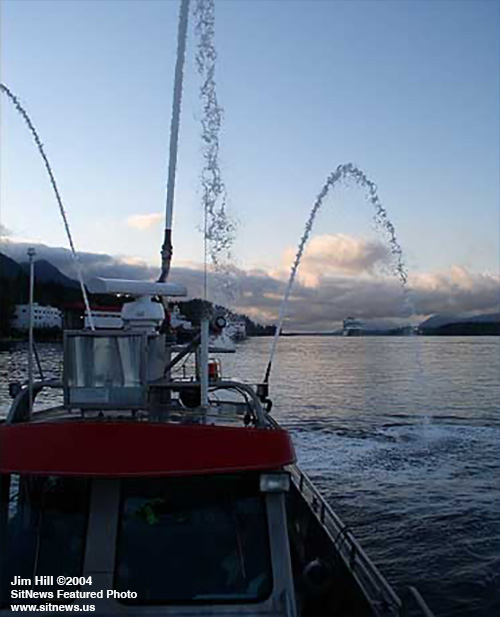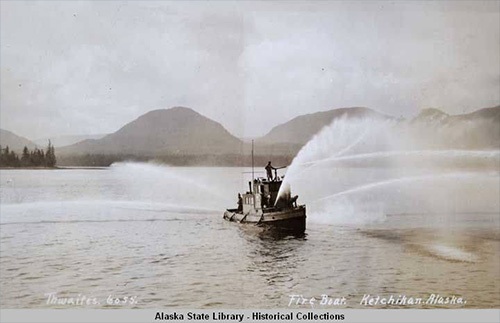The Ketchikan Fire Department's Fireboat Harry Newell cranks up its water hoses preparing to greet the Diamond Princess in May 2004. |
The Harry Newell is the second fireboat named after the only Ketchikan Firefighter to die in the line of duty.
On April 7, 1955, Harry Newell, 56, the Captain of the Ketchikan Fire Department was helping fight a fire in the basement repair shop of the Smith Electric Company in downtown Ketchikan. Newell and several other responders were overcome by smoke and gas, even though some – like Newell – were wearing air packs.
Former Ketchikan Firefighter Bud Silsbee was on duty that day.
“I was there at that fire, it was in the basement of the building,” Silsbee wrote on Facebook recently. “We could hear Harry calling for help but the smoke was so intense that you couldn’t see from the outside…so no one could get to him.”
Eventually, Newell and the others were pulled from the building. The other three firefighters and police officers were revived, but Newell died. Besides being the Fire Captain, Newell had also been the past leader of both the local Moose and Elks lodges in Ketchikan. He had lived in Ketchikan for 32 years.
A year before Newell died, the city had purchased a fireboat and named it the City of Ketchikan. It was renamed the HV Newell after his death. When it was replaced three decades later, in 1986, the new boat was named the Harry Newell.
When the Harry Newell arrived in Ketchikan, it made news in the August 1986 issue of the Maritime Reporter.
“Ketchikan, Alaska, a city five miles long and two blocks wide has acquired a new 30-knot fireboat capable of covering that expanse,” the magazine reported. “The all-aluminum Newell culminates a more than three-year effort by Ketchikan to replace a well-used 65-foot wooden fireboat, which despite its 4,000 gallon per minute pumping capacity was deemed too slow to serve the city.”
The story noted Ketchikan was continuing to expand along Tongass Narrows in the 1980s and that a faster boat was needed.
“With an overall length of 45 feet and beam of 12 feet, the new fire/rescue boat has a pumping capacity of more than 5,000 gpms through four fire monitors,” the magazine noted. “Propulsion is provided by two Detroit Diesel 6-17 turbocharged and Intercooled engines, each developing 410 horsepower…at a top speed of 30 knots.”
The Harry Newell was built by Workboats Northwest in Seattle with help from United Fire Service of Issaquah, Dafoe Machine of Vancouver B.C., and the Prop Shop of Lynnwood.
The following is a history of all the local “fireboats,” going back to 1905. It is based on research done by the Tongass Historical Museum in 2007.
In 1905, the Common Council of the town of Ketchikan authorized the purchase of a “scow” from Fidalgo Island Packing and a steam boiler and firefighting apparatus from H.C. Strong. The scow, apparently named the “Tag,” was purchased for $200 and the boiler and fire pump for $400. It was operational by the Fall of 1905.
The main reason for the scow was for the protection of “New Town” according to Town Council minutes, the area north of the bluff that is now the tunnel. New Town had been rapidly expanding since shortly before 1900, was quickly becoming the center of the local fishing industry and by 1905 had several small canneries in operation.
Unfortunately, by 1909, the fire department was reporting the scow was in “bad condition” and should be beached, according to Town Council minutes. There was discussion about removing the fire pumps from the scow and placing them in the boat Ella Rolffs, but that motion before the town council failed.
Eventually, in 1912, the scow was sold to Chas. Radenbaugh for $15.
For the next decade and a half, there was no fire department fire boat. Waterfront fires – and there were many at this time when much of Ketchikan was on pilings – were fought with varying degrees of success by private boats (many provided by the numerous canneries), US Lighthouse Service Cutters and US Forest Service Ranger Boats.
In the 1920s, rapid growth in the salmon canning industry caused Ketchikan’s population to double to more than 5,000 and the city council decided it was time for a fire boat for the community – which briefly was the largest city in Alaska.
In July of 1928, the fire department reported to the town council that it had purchased the gas tug boat Ruth for $500 and planned to turn it into a fire boat. The news appeared to catch the council somewhat by surprise but the council quickly voted to reimburse the department for the boat cost.
“A little over a month ago, the Ruth was up for sale and the members of the department who had often discussed the necessity of the greater protection which would…make use of a fire boat, purchased the Ruth out of their own funds,” the Ketchikan Chronicle reported in September of 1928. “It practically wiped out their balance but they did not hesitate, their long experience showing that on several occasions valuable property could have been saved by getting at the flames direct from the waterfront.”
The Chronicle reported that the 40-foot-long tug had an 80-horsepower Union engine with a top speed of 10 knots. It had a 1000 gallon per minute pump with a 150-horsepower Van Blerck engine.
After a year of operation, the fire department voted to change the name of the Ruth, according to the Chronicle in November of 1929.
Fire Boat Dale W. Hunt - Ketchikan, Alaska. |
“At their regular monthly meeting last night in the Elks Club rooms, the Ketchikan Volunteer Fire Department officially selected the name of ‘Dale W. Hunt’ as the name of their new fireboat, in honor of past Chief Hunt who was a peer among them and one of Ketchikan’s best firemen.”
In 1933, a new pump was installed raising the power to 1,500 gallons a minute. The next year, it was given a new task: fire, rescue and garbage disposal.
Because of work on the South Tongass Highway, the 4-12-1934 Chronicle reported that the town dump, located on the waterfront just south of the US Coast Guard base, was inaccessible.
“For a while it (the refuse) was dumped near Ward Cove, north of town, but this resulted in protests of the residents of that district,” the Chronicle noted.
So, a garbage raft was built by the city street department which would be “periodically towed by the fire boat…to some outside point,” the paper noted. “The box on the raft containing the refuse will be sluiced clean by the boat’s fire hoses.”
The boat’s skipper, Captain Joe Diamond, was not amused.
“I never thought the ol’ Hunt would come to this,” he told the Chronicle.
Eventually a new garbage dump was built, just north of the city, and the Hunt returned to its original purpose. For the next nearly 20 years it continued to fight boat, dock and harbor fires, being particularly useful in fighting cannery fires where the long perpendicular docks were often out of reach of fire apparatus back on Tongass Avenue.
One of the more spectacular fires that the Hunt was involved in fighting was the Standard Oil dock fire of July 30, 1952. In 2000, George “Bud” Beck presented his recollections of the fire the Ketchikan Museum collection.
“Colin Poole and I responded to the fire in the Hunt,” Beck wrote in 2000. “Since the boat could not get close enough to the (huge) fire to do any good, we stood by.”
They were joined on the boat by Paul Wingren, Cy Steers and Roy Selfridge who came out on a skiff from the nearby New England Fish Company plant.
“We then nosed into the main Standard Oil dock and the three men took a two-and-a-half inch hose line back across the dock to the area of the bit warehouse, which contained all the canned lube oil and other products,” Beck wrote in 2000. “As the picture shows, I was on the roof of the wheelhouse and was operating the monitor (pump) covering the three men on the dock.”
Beck said that the boat was in close proximity to the giant fire for about 20 minutes.
“At some point I was peering under the dock (I didn’t really like it there) and saw burning fuel spreading toward us,” he remembered in 2000. “I alerted Colin in the wheelhouse by stamping on the roof and told him to blow the siren which he did. The three men on the dock came running and jumped on the boat and we backed away, pulling the hose line with us… as we backed away, the Standard Oil plant, dock and all burst into a mass of flames. I remember being very discouraged and wondering what to do next.”
He said he watched as a tug pulled the Falls of Clyde, a four-masted schooner that had been converted to oil storage, away from the docks before it caught fire as firefighter fought to keep the blaze from spreading to nearby oil tanks and the South Tongass Highway. He said the battle with the fire lasted several hours.
“There was no doubt that had we not kept it back the fire would have spread to Union Oil, New England Fish Company, Fidalgo Island Packing Company and even the town,”Beck remembered. “At some point after we backed out, we started seeing oil drum lids flying around above us, like large frisbees, 23-inch steel disks. The fire was so intense that the lids were blowing off the hot drums. We had to keep a close watch to keep from getting hit.”
By the early 1950s, it was clear that once again, the city needed a new fireboat. The City of Seattle was surplusing one of its fireboats, the 65-foot wooden boat Ethel, which had been built in 1943.
The Fire Department purchased the Ethel for $9,500 and had it towed to Ketchikan where repairs and upgrades were made. It was put into service in 1954, the year after the Ketchikan Pulp Mill opened.
In 1955, it was rechristened the City of Ketchikan. Then after the tragic Smith Electric fire, it was named the HV Newell in 1956.
The 65-foot boat had two high towers on board with which to direct some of its initial 2,000 gallon per minute spray. It had a 215 horsepower Superior diesel engine which got it up to 12 knots and a 100-horsepower Cummins pump for the water. In the mid 1960s, the Cummins was replaced by a 6-71 GM Diesel that increased the flow to nearly 4,000 gallons per minute.
In a 1974 story, the Ketchikan Daily News noted that Ketchikan was only Alaskan city with its own fireboat. The article noted that the Newell was also capable of pumping out sunken vessel and had a very unusual piece of equipment called a “Spudg” according to Fire Chief W.A. Winston. Winston said that former department Lieutenant Bill Hagevig had designed the “self-propelled under dock gadget.” The Spudg was designed to float underneath docks and direct a stream of water upward to fight the dock fires from below.
When the HV Newell was replaced by the Harry Newell in 1986, it was converted into a fishing vessel and relocated to Astoria, Oregon where it was still registered as of 2004.
On the Web:
Columns by Dave Kiffer
Historical Feature Stories by Dave Kiffer
Dave Kiffer is a freelance
writer living in Ketchikan, Alaska. Dave Kiffer ©2023 Publication fee required. © |
Representations of fact and opinions in comments posted are solely those of the individual posters and do not represent the opinions of Sitnews.
Send a letter to the editor@sitnews.us
SitNews ©2023
Stories In The News
Ketchikan, Alaska
Articles & photographs that appear in SitNews are considered protected by copyright and may not be reprinted without written permission from and payment of any required fees to the proper freelance writers and subscription services.
E-mail your news & photos to editor@sitnews.us
Photographers choosing to submit photographs for publication to SitNews are in doing so granting their permission for publication and for archiving. SitNews does not sell photographs. All requests for purchasing a photograph will be emailed to the photographer.




